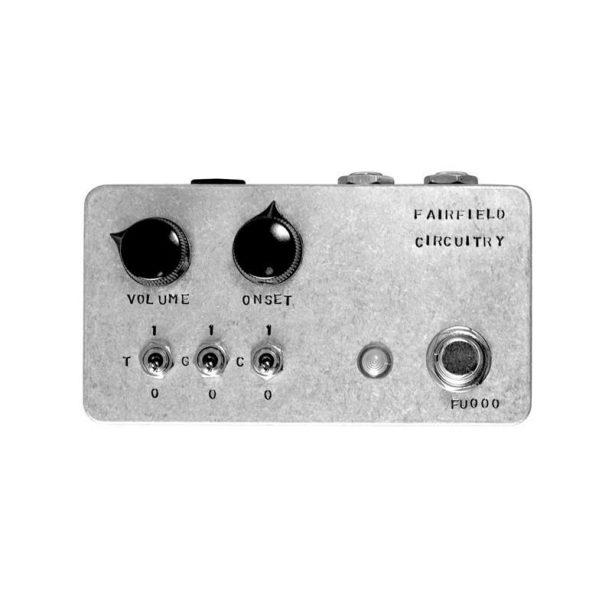
The Fairfield Circuitry Unpleasant Surprise is like the druggie stepbrother to the functional and dependable Barbershop. This box is marketed as a fuzz pedal but with so many strange possibilities that I wouldn’t put it in parallel with classic fuzz pedals such as the big muff or a fuzz face. It is possible to create wild growling fuzz distortions with gated dynamic reactions with The Unpleasant Surprise. As the name suggests, this is not a subtle or pretty pedal. My first reactions conjured up memories of Nine Inch Nails or How To Bury Strangers. There are only two knobs on The Unpleasant Surprise, but in conjunction with three switches, the possibilities of setting become large.
The knobs are output, volume, and onset. Onset controls the threshold of the gating function and the gain of the fuzz. As the onset is pushed clockwise, the fuzz element of the pedal becomes more apparent. In this position, the fuzz becomes sustained and playable in a traditional manner. As the onset is pulled counterclockwise, spitting gate artifacts mix into the signal.
The switches include treble cut, amplifier bias, and compression. The treble cut allows for a more useful fuzz sound at higher gain settings. It also pairs well with the compressor engaged. The compressor pinches the high end in a way that might cut through the mix in certain situations, but could also come off as overbearing in a sparse arrangement. The threshold of the compressor is controlled by the onset knob, which in practice acts more like a gain boost than anything else. If you have a wild sound going on without the compressor, engaging compression might make your sound just a little crazier.
The amplifier bias toggles between “open” and “saturated”. I found this to be the least useful control on the pedal, but only because it was less extreme. The saturated setting often aided in the wild and crazy settings and the open setting allowed for more of a functional fuzz. I often grabbed this pedal for noisy layered overdubs as opposed to a primary distortion for an overdub.
For the purpose of a crazy distortion, this pedal does great things. I had a great time putting it after a reverb return in a mix for a mangled reverb distortion. In a practical band setting I could see this pedal working best when used with a blend pedal to temper the chaotic and dissonant characteristics. – Shane O’Connor is a producer, mixer, and engineer located in Brooklyn. He has worked with Tab The Band, Talib Kweli, Xylofaux and Madi Diaz.
Fairfield Circuitry Unpleasant Surprise, Builder’s Notes
Reminisce about the time you got your shoulder caught in the reciprocating saw while this unit destroys your slick jazz lines.
The fruit of an oddball circuit, hanging there awkwardly by some parasitic effect. Tweaked, bended and shoe-horned to optimize it’s stench, it’s unpleasance. Time has come to turn all dynamics to shit. Strangely, it feels very natural.






















